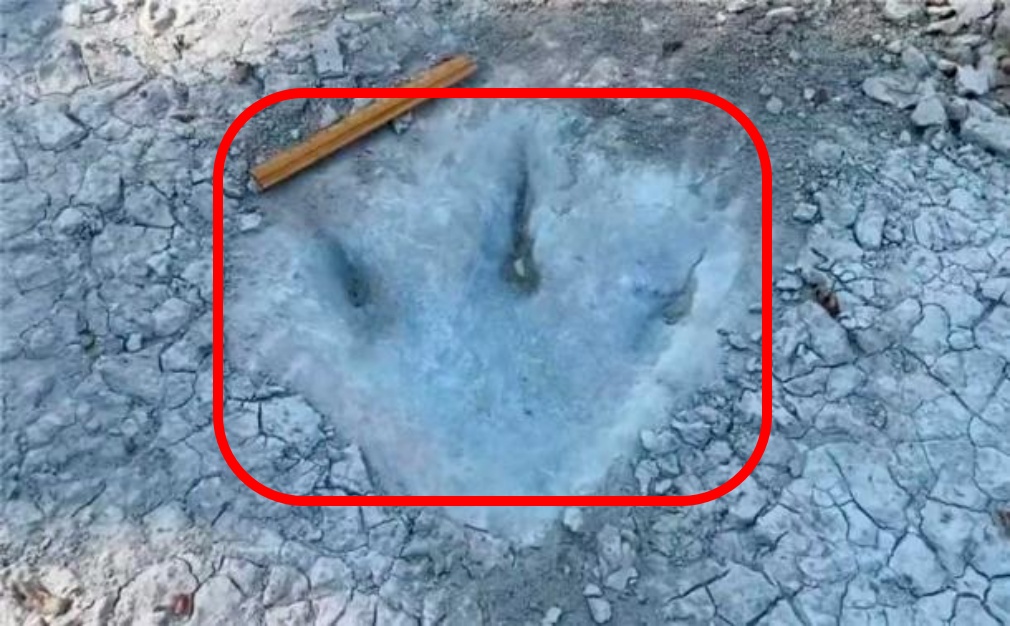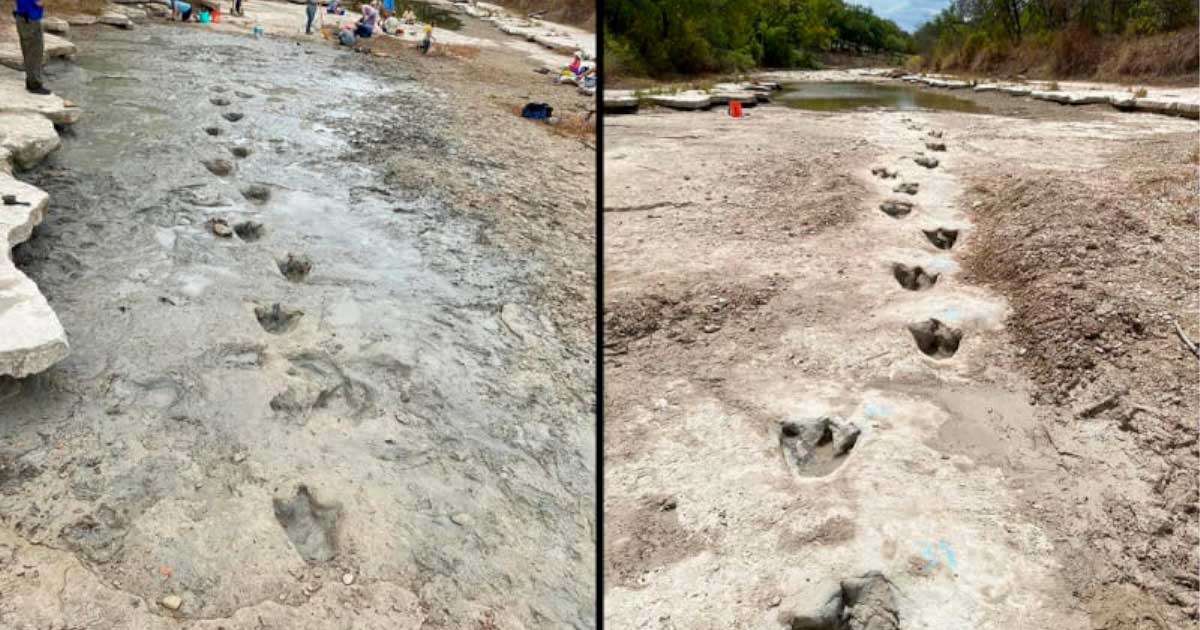A theropod dinosaur footprint that was previously discovered near Glen Rose, Texas’s Dinosaur Valley State Park.

A record drought in Texas has exposed a bunch of 110-million-year-old dinosaur tracks in yet another example of how climate change is both revealing new things and making us uncomfortable.
As lakes, rivers and streams dry up around the world, archaeological and anthropological gold is being revealed. This was made evident in Europe over the last week after a wealth of finds were reported.
Six days ago The Guardian reported that in the River Elbe, which connects the Czech Republic with Germany, a collection of mysterious 15th century “hunger stones” were revealed. Then, four days ago, Business Insider reported that in the Danube, near the Serbian village of Prahovo, two Nazi shipwrecks from 1944 appeared from the riverbed.
Now, in a freshly dried up riverbed at The Dinosaur Valley State Park in Texas, rare dinosaur tracks of have been exposed, measured, and filmed.
Rare Dinosaur Tracks On The Cretaceous Dino Highway of Texas
This summer has seen a severe lack of rain and record high temperatures in Texas. The Texas Tribune reports “27 percent of Texas is under an “exceptional drought warning while a further 62 percent is enduring an extreme drought.”
A report in IFLScience said the Dinosaur Valley State Park in Texas “was like a prehistoric highway in the early Cretaceous Period” but it is only after the recent severe droughts in the Paluxy River that silt was revealed in shallow water, in which the giant footprints were spotted.
Looted Ancient Roman Bust Found In Texas Thrift Shop
16,700-Year-Old Tools Found in Texas Change Known History of North America
The dinosaur tracks were first discovered in the early 20th century following a massive flood on the Paluxy River. At that time, paleontologists described three-toed theropod prints but later research also identified sauropod footprints which represent the first distinct sauropod tracks ever discovered, anywhere. So why here?
Texas Was T-Rex Turf But There Are Many Kinds of Theropods
According to the Bureau of Economic Geology website, about 120 million years ago in Texas bays and lagoons on the west shore of a shallow sea, dinosaurs walked across muddy-lime sediments. Fine silt and clay sediments then washed in from land areas to the north and west and buried the tracks beneath lime sand bars, which quickly cemented into hard limestone. Over the last 100 million years erosion of the Paluxy River has stripped off the softer shale but has left the limestone ledges in which the prints were identified.

Tracking The High Spined Lizard
Measuring over 30 centimeters (11.81 inches) each, from heel to claw, these new tracks are too small for T-rex, and were created by its cousin, Acrocanthosaurus.
According to ABCDino this “very large genus” was first discovered in Atoka County, Oklahoma in the 1940s, but it also roamed the ancient plains of what are today the states of Wyoming and Texas, around 110 million years ago.
The UK’s Natural History Museum refers to this particular creature as “an enormous carnivore” and its physical description is locked within its name. Pronounced “ah-kroh-kan-tho-sore-us,” this means “high-spined lizard,” a name chosen after scientists calculated it was 11 meters (36 feet) long.
However, as fascinating as these tracks are, they’ll have to go a long way to compete with the “twin sets of tracks” discovered in 1908 in limestone deposits along the Paluxy River, that brought the academic world to a standstill.
Did Archaic Humans And Dinosaurs Co-exist?
In 1908 it was clear that one of the sets of tracks was left by a giant dinosaur. However, the second set of prints was much smaller, and they were interpreted as “human,” sparking the debate as to whether humans and non-avian dinosaurs lived at the same time, or not?
Shocked, two leading anti-creationists, D. H. Milne, and S. D. Schafersman, at that time pushed back and wrote “such an occurrence, if verified, would seriously disrupt conventional interpretations of biological and geological history and would support the doctrines of creationism and catastrophism,” stated the Milne and Schafersman report.
New Mexico Mammoth Bones from 37,000 years ago “Upend” Clovis Theory
Whole Rattlesnake Including Fangs Found Inside Lump of Fossilized Human Poo
Eventually, after a long professorial fight, the second track was officially recognized as having been created by a small dinosaur. Notwithstanding, the modern Institute of Creation Research still finds a way to use these twin-prints to their advantage.
The institute’s website currently says that while the second set of prints are “too ambiguous to be used as an anti-evolution argument, they just might be coming into their own as good evidence for Flood catastrophism.”